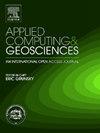利用钻探数据进行岩体分类的机器学习方法比较研究
IF 3.2
Q2 COMPUTER SCIENCE, INTERDISCIPLINARY APPLICATIONS
引用次数: 0
摘要
目前钻爆法隧道的岩石工程设计主要依靠工程师的观察评估。边钻边测(MWD)数据是一种在隧道开挖过程中收集的高分辨率传感器数据集,但未得到充分利用,主要用于地质可视化。本研究旨在将 MWD 数据自动转化为岩石工程的可操作指标。它旨在将数据与具体的工程行动联系起来,从而为隧道工作面前方的地质挑战提供重要的决策支持。该研究利用来自 15 座隧道的 500,000 个钻孔组成的大型地质多样性数据集,引入了在现实世界隧道工程中对岩体质量进行准确分类的模型。研究探索了传统的机器学习和基于图像的深度学习,利用表格和图像数据将 MWD 数据划分为 Q 类和 Q 值(描述岩体稳定性的指标实例)。结果表明,在使用表格数据的树状模型的集合中,K-近邻算法能有效地对岩体质量进行分类。在将岩体划分为 Q 类 A、B、C、D、E1、E2 时,其交叉验证平衡准确率为 0.86,而将 E 与其他岩体进行二元分类的准确率为 0.95。使用带有每轮爆破的 MWD 图像的 CNN 进行分类,二元分类的均衡准确率为 0.82。通过对表格式 MWD 数据的 Q 值进行回归分析,在与分类类似的集合模型中,交叉验证的 R2 和 MSE 分别为 0.80 和 0.18。回归和分类的高性能增强了对岩体自动评估的信心。在一个独特的数据集上应用先进的建模方法,证明了 MWD 数据在提高岩体分类准确性、推进数据驱动的岩石工程设计、减少人工干预方面的价值。本文章由计算机程序翻译,如有差异,请以英文原文为准。

A comparative study on machine learning approaches for rock mass classification using drilling data
Current rock engineering design in drill and blast tunnelling primarily relies on engineers' observational assessments. Measure While Drilling (MWD) data, a high-resolution sensor dataset collected during tunnel excavation, is underutilised, mainly serving for geological visualisation. This study aims to automate the translation of MWD data into actionable metrics for rock engineering. It seeks to link data to specific engineering actions, thus providing critical decision support for geological challenges ahead of the tunnel face. Leveraging a large and geologically diverse dataset of ∼500,000 drillholes from 15 tunnels, the research introduces models for accurate rock mass quality classification in a real-world tunnelling context. Both conventional machine learning and image-based deep learning are explored to classify MWD data into Q-classes and Q-values—examples of metrics describing the stability of the rock mass—using both tabular- and image data. The results indicate that the K-nearest neighbours algorithm in an ensemble with tree-based models using tabular data effectively classifies rock mass quality. It achieves a cross-validated balanced accuracy of 0.86 in classifying rock mass into the Q-classes A, B, C, D, E1, E2, and 0.95 for a binary classification with E versus the rest. Classification using a CNN with MWD-images for each blasting round resulted in a balanced accuracy of 0.82 for binary classification. Regressing the Q-value from tabular MWD-data achieved cross-validated R2 and MSE scores of 0.80 and 0.18 for a similar ensemble model as in classification. High performance in regression and classification boosts confidence in automated rock mass assessment. Applying advanced modelling on a unique dataset demonstrates MWD data's value in improving rock mass classification accuracy and advancing data-driven rock engineering design, reducing manual intervention.
求助全文
通过发布文献求助,成功后即可免费获取论文全文。
去求助
来源期刊

Applied Computing and Geosciences
Computer Science-General Computer Science
CiteScore
5.50
自引率
0.00%
发文量
23
审稿时长
5 weeks
 求助内容:
求助内容: 应助结果提醒方式:
应助结果提醒方式:


